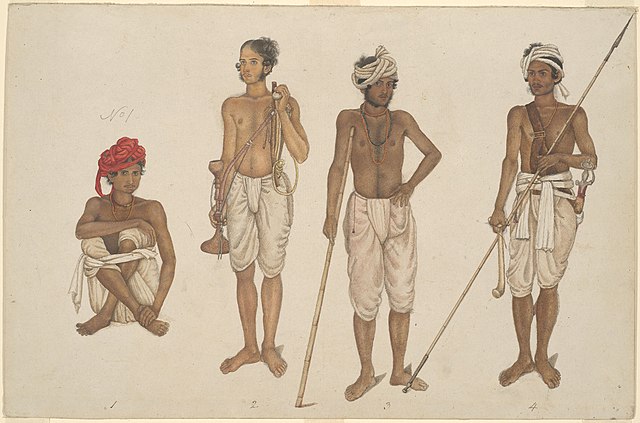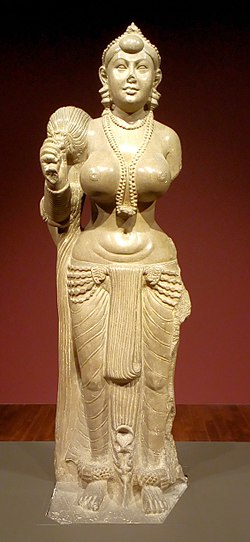Top Qs
Timeline
Chat
Perspective
Dhoti
Ethnic wrap garment worn by men in the Indian subcontinent From Wikipedia, the free encyclopedia
Remove ads
The dhoti is an ankle-length breechcloth,[1] wrapped around the waist and the legs, in resemblance to the shape of trousers.[2][3][4] The dhoti is a garment of ethnic wear for men in the Indian subcontinent.[5][6] The dhoti is fashioned out of a rectangular piece of unstitched cloth, of usually around 4 yards (3.7 m) in length.[7][8]


The dhoti is the male counterpart of the sari, worn by females to religious and secular ceremonies (functions).[9][10][11] A pitambar is a yellow silk dhoti worn on auspicious occasions.[12][13] Dhotis must not be confused with "readymade panchakachams"[14] or "dhoti pants", which are a new ready to wear trend, popular among women and typical of children.[15][16][17] Although the terms mundu or veshti are used interchangeably with "dhoti",[18] they are different from the dhoti, which is "looped" or wrapped around the legs, in the form of trousers or pants.[19] The dhoti is better known as panchakacham in South India, which may even be worn while doing dances such as moonwalks.[20]
Remove ads
Etymology
The unstitched dhoti is also referred to as "dhautra" (IPA: /dʱɑwtrɐ/) in Sanskrit, which means rope or cord. It evolved from the ancient antriya, which was passed in between the legs, tucked at the back and covered the legs loosely, then flowed into long pleats at front of the legs, the same way it is worn today as formal dhoti.[21]: 130 While a casual and short dhoti wraps around both legs firmly, in this style the back side of the dhoti is pulled to the front and tucked at the waist, before tucking the two loose ends at back, creating firmly fitted trouser-like dhoti that wraps around both legs. This style is more commonly worn by farmers and martial artists.[22][23] Stitched garments became popular in the Indian subcontinent, with the coming of Persians, Greeks, and "barbarians"; nonetheless, the dhoti prevailed in sakaccha as well as vikaccha forms.[24]
Remove ads
History
Summarize
Perspective

The dhoti evolved from the ancient antariya, which was passed in between the legs, tucked at the back and covered the legs loosely, then flowed into long pleats at front of the legs, the same way it is worn today as formal dhoti.[25] A l and short dhoti wraps around both legs firmly, in this style the back side of the dhoti is pulled to the front and tucked at the waist, before tucking the two loose ends at back, creating firmly fitted trouser-like dhoti that wraps around both legs. According to G. S. Ghurye, this style is more commonly worn by farmers and martial artists.[25][26]
The earliest epigraphical depictions of the Dhoti were during the Mauryan Empire. In the Sunga period, there were two broad modes of wearing the dhoti, the sakaccha and the vikaccha.[27] Stitched garments became popular in the Indian subcontinent, with the coming of Persians, Greeks, and "barbarians"; nonetheless, the dhoti prevailed in sakaccha as well as vikaccha forms.[28] In the sakaccha way, the cloth passed between the legs and was tucked at the back; vikaccha meant wearing the dhoti similar to a lungi.[29]

During British rule in colonial India, the dhoti remained a national symbol of resistance and cultural identity when worn without a shirt.[30][31][32] At the height of the Indian Independence Movement, weaving khadi was a symbol of the swadeshi movement.[33] In 1921, Gandhi championed the dhoti, often topless (without a kurta or shirt), to promote and identify with the handicrafts produced by the rural and the poor of his homeland.[34][35]
Remove ads
Names



The garment is known by various names based on language, such as:
Custom and usage
Summarize
Perspective
The pancha is worn by many conservative Jain men when they visit derasars or basadis for puja, as unstitched clothing is believed by some Jains to be "less permeable to pollution" and therefore more appropriate for religious rituals than other garments.[36] They also wear a loose and unstitched cloth, shorter than the pancha on top.

The International Society for Krishna Consciousness (ISKCON), known for its distinctive dress code, prompts Western adherents to wear pancha, usually of saffron or white cloth folded in ethnic Bengali style. Maharishi Mahesh Yogi was known for wearing a white silk dhoti.[37] Traditionally, men wear the dhoti topless (without upper garments) while entering certain mandirs (Hindu temples) in South India, as stitched garments supposedly counter the energy of the idol.[38][39][40][41] The dhoti is often worn with a shirt in other places.[42]
The dhoti was also worn by Sikhs in the Punjab region, etc. Wearing Dhotis was discouraged during the Punjab Subah Movement due to the inter-communal tensions prevalent at the time.[43][44] The dhothi was also worn by South Canarese Christian men to their pre-nuptial ceremonies, church weddings & receptions until the 1960s;[45] after which they fell out of favour, since then, grooms have been styling the black suit and tie instead.

There is a distinction between the dhoti and the lungi, a similar garment often worn by people at their homes. The lungi is more casual and comfortable, while the dhoti is considered formal and is sometimes worn by politicians.[46]
Remove ads
Decline
The use of dhoti an as article of clothing has declined for multiple reasons. However they are still used in secular & religious settings.[47][48] The sari is still draped by many women as daily wear, while few men know how to wrap the dhoti and use it every day.[49] The dhoti has been displaced by the "English clothes" of the British, in urban areas like Bombay (Mumbai).[50] In the past, there were variations in the styles of wrapping the dhoti based on castes, as in the case of Bombay's Sonars and the Peshva Brahmins; for this reason, English attire has been described as "caste neutral".[51][52][53] Men in dhotis are perceived as poor, in places such as shopping malls.[54] Additionally, with the introduction of kurta-pyjama sets from Central Asia, during the Moghal Empire, pyjamas are often worn instead of dhotis as ethnic menswear.[55][56]
Remove ads
Gallery




See also
References
Wikiwand - on
Seamless Wikipedia browsing. On steroids.
Remove ads

